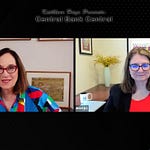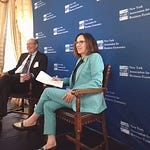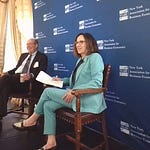Jim Bullard has always been an independent and original thinker, from the time he joined the Federal Reserve Bank of St. Louis as a research economist in 1990, rose to be reserach director, and served as President of the Bank in 2008 to 2023.
An important example of Jim’s thought leadership in the Federal Reserve system came during the pandemic inflation surge. In 2021 when consumer price inflation was soaring to nearly 9%, Jim started pushing for more aggressive 75% rate hikes that are widely credited with finally breaking the upward price momentum and turning inflation around.
Jim left the St. Louis Fed in 2023 to take over as Dean of Purdue University’s Mitch Daniels School of Business, and continues to speak, write and research various aspects of macroeconomics and monetary policy.
He joined me at the Hoover Institution’s back-to-back monetary policy conferences this week, one celebrating John Taylor and his Taylor rule, and the other to look at the challenges ahead for monetary policy in the U.S. and globally. I was eager to hear what he thinks of the impact of Trump tariffs not only on the economy, but also importantly what they meant for the Federal Reserve’s policy decision and what it means for potential rates moves over the course of this year.
So dive in and hear what Jim has to say. One of the most interesting parts of our discussion for me was his views on tariffs. He says there is a mafor risk that this could turn out badly but more so than many other economists he sees a path where the outcome could be positive for the both sides of the negotiations. And, at least for now, why he sees an economy that is resilient, and an inflation rate that he expects to gradually decline in the months ahead.
Fed on Hold as Negotiations Could Go Badly, Or Could Reduce Trade Barriers 00:01:25:1
I think it was hard for the committee to really go in any particular direction here with so much uncertainty about trade policy. I've been emphasizing that, you know, it could go badly. You could have other countries deciding that they simply wanted to put up even higher trade barriers. But it also could go very well. And you get a lot of negotiation going on and you might actually reduce some of the trade barriers across the world, and that would be a very good outcome.
Fed Focused on Resolution of Uncertainty 00:01:46:15
So I think from the Fed's perspective, this isn't really about where the interest rate is going to be. This is about waiting to see if sodeme of this uncertainty gets resolved before they move again. I think I think markets, though, have sniffed this out. I think that they've decided that, sure, there's a very pessimistic outcome and you're taking some risk here and in jumbling the whole world on access to U.S. markets. But on the other hand, for many countries or maybe all countries, the incentives really are to see if they can get to some deal because the U.S. market is a big one and a rich one in the world. And most countries would like access to U.S. markets. So, you know, maybe it'll all work out very well. And so we'll see. And it's you know, the president is a very good negotiator. So in that sense, you know, staking out the a very strong position at the beginning, that's a natural thing for a big negotiator to do. And we'll see if it's successful.
Pre-existing Trump tariffs conditions were not optimal 00:04:12:06
And most of these countries around the world are much smaller than the U.S. And so for them, they've got a few industries. They're very dependent on those few industries. And also, I think you said everybody should just keep in mind that it's not the U.S. as protectionist. Almost all the other countries in the world are the protectionist ones, and they do have a lot of trade barriers and they do want to have internal political lobbying back to the government to get protection for the industries that they do have in that country because they don't want to compete against the against the Americans or the Europeans. And so that's part of the dynamic. I think some of this has been portrayed as like all of a sudden the U.S. is protectionist and the rest of world isn't. But that isn't the right way to think of it. And exhibit one is China. China's mercantile is through and through. And so that's really what has brought this issue, I think, to the to the fore even more than it was in past decades.
Just get out there and compete! 00:06:03:08
I think you’ve got many countries feeling like they've only got a few industries. They don't really want to compete against the big American companies. And you can't really blame them in some ways because those are very good companies. One thing I would say about trade in the postwar era and since the Reagan era, the Reagan era was, you know, all about free trade and globalization. And they were especially big on that and getting access to foreign markets for U.S. companies. And it was all about competitiveness. You know, it was an uneven playing field globally. But, hey, get out there and compete. And so what did you get out of that? Many of the top companies in the world are American based, and so they did exactly that. They had to compete, so they competed. And now you've got 40% of world market capitalization as U.S. companies. So I think there really is a downside over the medium term in the long run to have too much protection for your industries in your particular country, because then Europe, your guys won't compete effectively. Maybe it works for a month or two or a year or two, but over the long run they don't compete effectively and they rely too much on protection.
Current account/capital account imbalances 00:07:18:20
I think that, you know, what are you other people or more in your camp point out to the fact that we've got this large current account deficit and if change rates adjust, then you have that balancing all the time. Your dollar should weaken or something like that. People say, Oh, but people you guys want to buy stuff and we want to buy treasuries and that and that's the reason why the reason why that you have this large current account deficit and exchange rate that doesn't adjust, etc.. Yeah, I think, you know, with the current account and the capital account, you know, they are two sides of the same coin and I think you always have to keep that in mind when you're thinking about the global balance as supposed to be globally it's supposed to balance the numbers actually don't add up around the world. So that's another puzzling thing.
Perspective on current policy 00:08:48:17
You know, I think the committee should refer back to the fact that they you know, they lowered the policy rate 100 basis points last year, partly based on a growth scare, just because you said they needed to start cutting rates. They did partly they did that partly based on a growth scare that did not materialize. So in a way, the rationale was kind of undone by the data later in last year, but nevertheless, 100 basis points lower. And most would say, well, that effect is coming online right now. The main part of that effect in the first half of 2025 here. So they already have lowered rates, but inflation still a little bit above target. So they're keeping rates a little bit high. And why do anything when there's so much uncertainty about policy? So those are the things that are driving it, right.
2018, 2019 Tariff impact and Fed’s Policy Reaction 00:10:07:23
The lesson in 2018, 2019… the lesson I took away from it, was that the growth effects were tangible, the inflation effect, the I didn't really see it. In fact, inflation by the Fed's preferred measure declined in the first half of 2019. And the Fed, by the time you get to the middle of 2019, it was clear that the economy is slowing down markedly and that and that inflation was actually lower, not higher. And so the Fed lowered the policy rate during that period, and I thought that was the right decision. I actually, I think, dissented. So they would go a little faster. But the but, you know, the lesson is that the uncertainty about the trade policy, forget about the actual tariffs, just the uncertainty. You don't know the rules of the game. And because you don't know the rules of the game and you're talking about the biggest corporations in the world, they're all going to wait and see. Let's find out what the rules are. And they won't build that billion dollar plant in Malaysia or the of a $5 billion plant in California or whatever they're going to do. You see more rate cuts this year, 2025?
Looking for rate cuts? 00:11:24:15
I do, but not until later in the year. I would say, you know, it's not it's not easy to have a base case here with this kind of situation. But I think if if you do get some of the trade deals and you do get a de-escalation going on, especially with China, then then you might be in a position to lower the policy rate, let's say starting in September.I don't think it would be a dramatic easing. I think it would be maybe a couple of moves.
Profiles in Fed Credibility 00:16:16:17
And I think what the committee has in mind and me, maybe most observers have in mind, is that when inflation, for whatever reason, inflation gets away from you and it's well above target, you have to do what Volcker did and you have to raise the policy. Yes. And you have to convince people that you're serious. That's a credibility angle and that's how you get inflation back down to 2%. But there's another side to the coin, and that's the one that we saw in 2010 to 2019. Inflation persistently below target, flirting with going down to zero or even negative the way it did in Japan. And, you know, it's maybe a less urgent situation, but boy, it goes on for a long time. You have all this debt around the world trading at negative nominal interest rates and growth didn't seem to like explode or anything. So it's I think that hurts the credibility of the central bank as well. So there you have to have other strategies that are going to move the inflation rate back to the 2% target. Otherwise you lose credibility or 2% target and you get mired in a Japanese style outcome. Do you what do you expect to come out of this framework review?
Policy and the Taylor Rule 00:19:07:23
How far is inflation from target? And the other one is the output gap hours. How far is output from where you think it would normally be? And it gives you how much you should adjust based on both of those gaps. So actually, in recent interviews I've seen people have been talking about, in fact, in that press conference just yesterday or the day before, I guess, you know, Chair Powell was getting a lot of questions about, well, if you're if the unemployment rate went up, the such and such about inflation went up sometimes as well, what would you do? And I kind of at some point I felt like he should just say, you know, consult your Taylor rule, because that's exactly what it said. Yes. It tells you exactly how much to adjust or if one is above or one is below, it tells you exactly what to do in all those situations. So that's what's made it so useful. I think. Is it just distilled down to just to such an understandable equation, so much of what had been packed in complicated papers and stuff earlier.
Importance of the Taylor Rule 00:21:58:22
I think it was very important. And another thing about the 1980s, when I was in graduate school and everything, everything was about money. You had Larry Christiana, chair, you read his papers at the time. They're all about money, They're all about reserves. How does reserves become money? How much money? And everything's about money. So the idea that you could get to something that policymakers were actually talking about, which was interest rates and do it in a way that was consistent with the theory that that was very important.
Jim Bullard
Dr. Samuel R. Allen Dean of the Mitch Daniels School of Business
Distinguished Professor of Service and Professor of Economics
Special Advisor to the President
Education
Ph.D., Economics, Indiana University, Bloomington, Indiana, 1990.
Bachelor of Science, Quantitative Methods and Information Systems, and Economics, St. Cloud State University, St. Cloud, Minnesota, 1984
James “Jim” Bullard, former president of the Federal Reserve Bank of St. Louis and one of the nation’s foremost economists and respected scholar-leaders, was chosen in July 2023 as the inaugural dean of the reimagined Daniels School of Business at Purdue University.
Bullard, who took the reins as the Dr. Samuel R. Allen Dean on August 15, 2023, is charged with inspiring, further developing and implementing Purdue’s reimagined approach to a top-ranked business school across undergraduate, graduate, executive and research programs, preparing tomorrow’s business leaders and entrepreneurs in the Daniels School that is grounded in the principles of free enterprise, free market economy in generating opportunities and prosperity, and in the hallmarks of a well-rounded Purdue education and with a particular emphasis on tech-driven, analytics-based business success.
To further reflect and to maximize the impact of Bullard’s unique, national leadership experience, he also serves as Special Advisor to the President of the university, reporting to President Mung Chiang in that capacity. Bullard is also a Distinguished Professor of Service and Professor of Economics in the Daniels School.
Serving 15 years as the sitting president and chief executive officer of the Federal Reserve Bank of St. Louis, Bullard earned significant praise and accolades for his long-standing leadership and innovative thinking as part of the Federal Open Market Committee (FOMC) in guiding the direction of U.S. monetary policy. A noted economist and scholar, Bullard had been the longest-serving Federal Reserve Bank president in the country and ranked as the seventh-most influential economist in the world in 2014. His scholarly impact has been based on research-based thinking and intellectual openness to new theories and explanations. That allowed Bullard to be an early voice for economic change, helping the Federal Reserve deftly navigate complex economic landscapes such as the COVID-19 pandemic and the financial crisis during his tenure.
Before becoming president in 2008, Bullard served in various roles at the Federal Reserve Bank of St. Louis, starting in 1990 as an economist in the research division and later serving as vice president and deputy director of research for monetary analysis. For 15 years, he directed the activities of the Federal Reserve’s Eighth District, which branches into several states, including an extensive portion of southern Indiana. While serving on the Federal Reserve’s Open Market Committee, Macroeconomic Advisers named Bullard the FOMC's second biggest mover of markets in 2010 behind Chairman Ben Bernanke and the biggest mover of markets in 2011 and 2013.
During his time as an academic economist and financial policy scholar, Bullard’s research has appeared in premier journals, including the American Economic Review; the Journal of Monetary Economics; Macroeconomic Dynamics; and the Journal of Money, Credit and Banking. The majority of his research is some form of macroeconomic analysis, focusing on monetary policy, inflation/deflation, and macroeconomic stability.
Bullard served as an honorary professor of economics at Washington University in St. Louis, where he also sat on the advisory council of the economics department as well as several advisory boards. The St. Louis Post-Dispatch named him the Top Workplace Leader among the region’s large employers as part of its 2018 Top Workplace Awards. Active in the community, Bullard has served on the board of directors of Concordance Academy of Leadership in St. Louis and was formerly the board chair of the United Way U.S.A. He is co-editor of the Journal of Economic Dynamics and Control, a member of the editorial advisory board of the National Institute Economic Review and a member of the Central Bank Research Association’s senior council.
Born in Wisconsin, Bullard grew up in Forest Lake, Minnesota, and received his doctorate in economics from Indiana University in Bloomington. He holds Bachelor of Science degrees in economics and in quantitative methods and information systems from St. Cloud State University in St. Cloud, Minnesot














Share this post